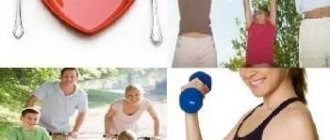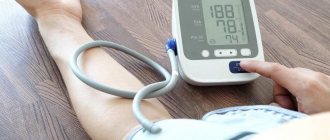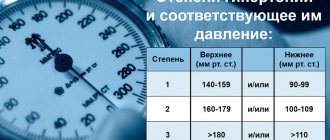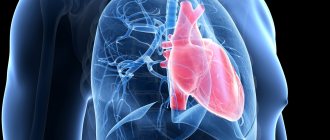Causes of high blood pressure
High blood pressure is divided into 2 types:
- primary (essential) hypertension (or hypertension) is the most common type of high blood pressure, often has no cause, develops over many years, the risk increases with age;
- secondary hypertension occurs against the background of the development of any disease (kidneys, endocrine system organs, sleep apnea) or taking certain medications.
Causes of high blood pressure include:
- old age (the older a person is, the higher the likelihood of developing hypertension);
- family history of the disease (high blood pressure in parents or other close relatives);
- unhealthy diet - diet high in salt and fat;
- lack of physical activity;
- overweight, obesity;
- sleep disorders;
- chronic diseases (chronic kidney disease, endocrine disorders, diabetes, high cholesterol);
- race (eg, African Americans have a higher risk);
- gender (in middle age, high blood pressure develops more often in men, in old age - in women; women who had high blood pressure during pregnancy are more prone to arterial hypertension in old age);
- certain medications (contraceptives, decongestants, NSAIDs, antidepressants);
- stress;
- smoking;
- alcohol abuse;
- non-compliance with sleep schedule, night shift work.
High blood pressure is often called the “silent killer” due to its lack of noticeable symptoms. In some cases (especially when blood pressure levels reach dangerously high levels), a person may complain of headache, nosebleeds, and shortness of breath. Many people do not associate these symptoms with abnormal blood pressure readings because they are not in the habit of periodically monitoring their blood pressure with a doctor or at home.
Why is hypertension dangerous?
High blood pressure significantly increases the load on the cardiovascular system. The risk of cerebral vascular rupture increases, which is accompanied by hemorrhagic stroke. The disease also contributes to the formation of atherosclerotic plaques and intravascular blood clots, which ultimately causes myocardial infarction, trophic disorders in tissues, and cerebral ischemia.
Episodic high blood pressure, the causes of which are external influences (physical activity, stress), is less dangerous. However, against the background of existing atherosclerosis, it can become a factor in the development of vascular embolism. In addition, there is a risk of damage to the wall of the cerebral arteries with the formation of a cerebral hematoma. Frequent or constant increase in blood pressure leads to the development of secondary wrinkled kidney, left ventricular hypertrophy, and heart failure.
Blood pressure readings
- Normal pressure is from 90/60 mm Hg. Art. up to <120/80 mmHg Art.
- Prehypertension (risk factor for the development of arterial hypertension) - 120–129 mm Hg. Art. / <80 mmHg Art.
- Arterial hypertension 1st degree - 130–139 mm Hg. Art. or 80–89 mm Hg. Art.
- Arterial hypertension 2 degrees - ≥140 mm Hg. Art. or ≥90 mm Hg. Art.*
*American Heart Association classification.
Online blood pressure calculator on the NHS website.
American College of Cardiology online cardiovascular risk (stroke, heart attack and other diseases) calculator (risk of complications for patients with high blood pressure over the next 10 years and beyond).
Palpitations, arrhythmia
The main target organs suffering from increased pressure are the brain and heart. Therefore, hypertension often manifests itself as symptoms of their damage. If in relation to the brain it is headache, dizziness and vomiting, then in relation to the heart:
- Palpitations.
- Frequent pulse.
- Interruptions and irregularity of rhythm (arrhythmia).
About 70% of women with high blood pressure report signs of arrhythmia. More often, complaints occur as an attack and are described as a feeling of one’s own heartbeat (as if the heart is jumping out of the chest). A healthy person should not feel his heart contracting, but during a hypertensive crisis this feeling is present.
If you count the pulse at this time, it turns out that it exceeds 90 beats/min, and may be irregular or intermittent with different intervals between successive contractions (beats). If you have heart problems, severe interruptions are possible - atrial fibrillation, paroxysmal tachycardia, extrasystole, atrial and ventricular fibrillation.
How often should you check your blood pressure readings?
Blood pressure is usually measured when visiting a doctor (for example, a therapist). There is no need to specifically visit a specialist for this; it is enough to ensure that the pressure is measured at least once every 2 to 5 years, starting from the age of 18 (with normal blood pressure and no increased risk of cardiovascular diseases).
People over 40 years of age, and people 18–40 years of age at risk of high blood pressure, should have their blood pressure checked at a healthcare facility at least once a year. If a diagnosis of arterial hypertension has been established or a person has other risk factors for developing cardiovascular diseases, it is recommended to measure blood pressure more often and not neglect monitoring at home. Your doctor will help you choose a device for measuring blood pressure (tonometer).
For children 3 years of age and older, blood pressure is measured regularly during annual routine examinations.
Caution: The American Heart Association does not recommend the use of wrist- or finger-worn blood pressure monitors, which are less accurate.
If recommended, measure blood pressure at home twice a day on the left and right arm: in the morning before breakfast (but not immediately after waking up) and before taking any medications, and in the evening, preferably at the same time. In each case, you need to measure the pressure 2-3 times (at short intervals, 1-3 minutes) for a confident, accurate result. 30 minutes before, do not smoke, do not eat, do not drink coffee (and alcohol), do not exercise, and empty your bladder. During the measurement, you must sit in a comfortable position, leaning back in a chair or armchair, do not cross your legs and ankles, and do not talk. The arm on which the cuff is worn must be freed from clothing and held at heart level; it is most convenient to place it on a table or armrest of a chair. Don't forget to write down your measurement results.
Chest pain and shortness of breath
As pressure increases, the heart muscle experiences increased stress, trying to overcome the increased resistance in the blood vessels. At this time, her need for oxygen and other nutrients increases, and blood supply decreases. If a woman has any problems with the patency of the coronary vessels (coronary artery disease, angina pectoris, previous heart attack), then at the height of a hypertensive crisis she complains of:
- pain in the heart or behind the breastbone;
- discomfort in the left half of the chest, neck or under the shoulder blade;
- feeling of lack of air;
- shortness of breath (breathing frequently and shallowly).
Hypertensive crises in 20% of women are complicated by angina pectoris, acute coronary syndrome or myocardial infarction. Therefore, even those who do not have any heart problems, but with increased pressure begin to feel any pain in the heart area, should be examined for coronary artery disease.
Is it possible to normalize high blood pressure and what to do?
Yes, with the help of lifestyle modification (influencing modifiable factors), treating the underlying disease, taking medications that normalize blood pressure.
Lifestyle modifications include proper nutrition, including avoiding fatty foods and reducing salt intake (the DASH (Dietary Approaches to Stop Hypertension) eating plan recommended by the US National Heart, Lung, and Blood Institute is preferred); weight normalization; quitting smoking and alcohol; regular physical activity; stress management (for example, mastering relaxation techniques).
If you have persistently high blood pressure due to a medical condition (such as diabetes) or caused by taking certain medications, it is recommended that you consult your doctor. Control of the underlying disease, refusal of drugs (or their replacement) that increase blood pressure, make it possible to stabilize the patient’s blood pressure and condition.
Nonmodifiable risk factors associated with high blood pressure include age and family history.
Prevention measures
Measures to prevent hypertension include:
- regular physical activity;
- giving up alcohol and smoking;
- balanced diet.
- dosed consumption of table salt (no more than 5 g per day).
Also, do not forget to regularly measure your blood pressure with a tonometer, which will allow you to notice its increase in time and seek medical help.
Treatment of high blood pressure
Treatment of arterial hypertension is based on lifestyle modification, constant monitoring of blood pressure, and the use of antihypertensive drugs (medicines that lower blood pressure) - one or more, based on the patient's individual situation.
Medicines prescribed for high blood pressure include: ACE inhibitors, angiotensin II receptor inhibitors, calcium channel blockers, diuretics, beta blockers, alpha blockers, alpha beta blockers. In most cases, these medications do not cause side effects. However, you should not self-medicate; you should consult a doctor who will select an effective drug and prescribe a regimen for its administration. It is important to follow all recommendations, observe the dosage and not skip taking the drug(s).
When diagnosing arterial hypertension, 24-hour blood pressure monitoring (ABPM) provides an accurate idea of the patient’s blood pressure levels. ABPM also excludes the factor of chance, distortion of real blood pressure readings (the so-called “white coat” syndrome or “white coat” hypertension), and registers imperceptible changes in blood pressure (for example, during sleep). This test is recommended by the American Heart Association to confirm the diagnosis of hypertension.
Effects of hypertension on the heart
Hypertension affects the entire body, but the target organs that come under attack suffer the most. First of all, the following organs and systems are at risk: blood vessels and heart, brain, kidneys and organ of vision.
It is worth noting that with increased intravascular pressure, the heart is subjected to heavy load, because the main task of this organ is to provide the entire body with the optimal amount of blood. Consequently, blood enters the ventricles in a volume less than normal, and the heart begins to work more actively to complete the task. Then the person's heart rate increases.
Because of this factor, an enlargement of the heart cavity may be observed, diseases may develop, and the working life of the main organ may decrease. In this case, a person may experience shortness of breath and swelling of the limbs.
Consequently, if hypertension was not detected in a timely manner, the heart begins to work unstably, causing disruption of intravascular blood flow and, as a result, the condition of the blood vessels themselves deteriorates.
We use treatment methods such as:
- Manual therapy;
- Osteopathy - treatment by the hands of a doctor, a gentle effect on the musculoskeletal system, nervous and vascular systems, internal organs;
- Medical massage;
- Acupuncture - exposure to biologically active points with microneedles;
- Laser reflexology is a painless effect on reflexogenic zones and points;
- Tsubotherapy is a gentle effect on the body’s reflex points;
- Pharmacopuncture - the introduction of medicinal drugs of natural origin to the source of the problem;
- Plasma therapy is the introduction of the patient’s own purified blood into the site of the disease;
- Isometric kinesiotherapy - individual gymnastic techniques/exercises, according to indications, with elements of joint massage;
- Kinesiotherapy using the Exart installation;
- Kinesio taping;
- Ozone therapy - treatment with active oxygen;
- Physiotherapy;
- Physiotherapy with enzyme preparations;
- Therapeutic droppers;
- Hirudotherapy - treatment with leeches;
- Botulinum therapy is treatment with botulinum toxin preparations.
How to quickly lower blood pressure at home
Let’s say right away: if your health is dear to you (and we believe it is), you should consult a therapist with complaints of hypertension. Depending on your blood pressure level, your lifestyle and other factors, your doctor will select an individual prevention and treatment plan for you and, most likely, prescribe medications that will help bring your blood pressure levels to normal levels.
But if for some reason you haven’t seen a doctor yet, here are a few ways to help lower your blood pressure. Choose the one that seems most comfortable to you, or combine several to achieve maximum effect.
Breathe deeper
As HEART HEALTH Just Breathe: How to Use Breathing Exercises to Lower Blood Pressure studies show, proper deep breathing is one of the most effective ways to quickly lower blood pressure.
- Relax, close your eyes. This will help reduce stress levels - one of the main triggers of hypertension.
- Take a deep breath, counting to 5. Inhale not from your chest, but from your stomach. To control, place your hand on it - you should feel your stomach rise.
- Then exhale and count to 5 again.
Breathing deeply for 3 to 5 minutes will increase blood flow to all tissues of your body, including your limbs. Due to this, the pressure in the vessels will decrease.
You can try holding your breath after exhaling for 8-10 seconds - choose the exercise option that seems more comfortable to you.
Take a hot bath
Pour water at a temperature of about 45 °C into a basin and immerse your hands or feet in it for 10 minutes. Hot water will cause the vessels in the extremities to dilate, blood will flow to them, and blood pressure will decrease slightly.
Take a dip in cool water
Lie up to your shoulders in a 32-degree bath. The body will cool down, the body will lower the pulse rate, and this, in turn, will reduce Scientific Evidence-Based Effects of Hydrotherapy on Various Systems of the Body pressure by 11-12%. If you hold only your hands in cool water, it will not have any effect.
Drink warm mint tea
Brew a pinch of mint leaves with boiling water for 10 minutes, let cool and drink the tea in slow sips. In this form, peppermint may reduce Effects and Safety of Menthol on Blood Pressure and Metabolic Parameters in Prehypertensive and Mild Hypertensive Patients (ESMAB) blood pressure.
Make a compress with apple cider vinegar or drink vinegar water
Soak gauze in apple cider vinegar (3-9% concentration) and apply the damp cloth to your feet for 10-15 minutes. This is a popular folk method. True, there is no convincing evidence of its effectiveness today (scientists simply have not tested whether a compress can lower blood pressure). However, in some cases, vinegar can really help.
Thus, Vinegar: Medicinal Uses and Antiglycemic Effect has established that apple cider vinegar contains substances that, when taken orally, can lower blood pressure (at least it works in rats). The research has not yet been completed, but it clearly has prospects.
Therefore, if you want to use apple cider vinegar to lower your blood pressure, it is scientifically more effective to take it internally. For example, adding Using Apple Cider Vinegar to Help Lower Blood Pressure a teaspoon of liquid to a glass of water.
As a rule, table vinegar is safe in this form (exactly as it is safe when dressing salads). But keep in mind that you should avoid this method if your teeth hurt or you experience heartburn, nausea or indigestion after consuming it.
Take valerian
Or drugs based on it, for example Corvalol. Valerian is a powerful sedative that helps the body cope with stress. The heart will begin to beat more calmly, and blood pressure will decrease. Important: when taking, do not exceed the dose indicated in the instructions!









